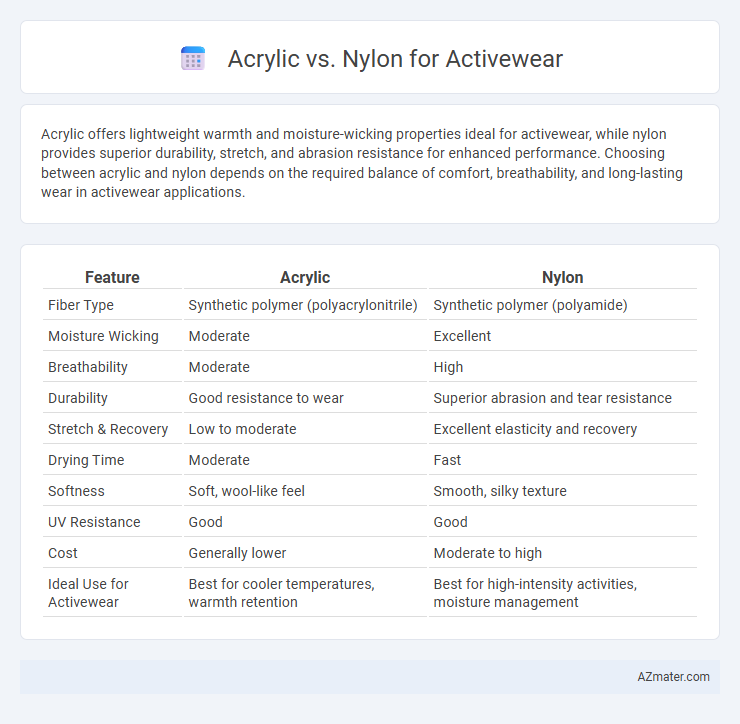Acrylic offers lightweight warmth and moisture-wicking properties ideal for activewear, while nylon provides superior durability, stretch, and abrasion resistance for enhanced performance. Choosing between acrylic and nylon depends on the required balance of comfort, breathability, and long-lasting wear in activewear applications.
Table of Comparison
| Feature | Acrylic | Nylon |
|---|---|---|
| Fiber Type | Synthetic polymer (polyacrylonitrile) | Synthetic polymer (polyamide) |
| Moisture Wicking | Moderate | Excellent |
| Breathability | Moderate | High |
| Durability | Good resistance to wear | Superior abrasion and tear resistance |
| Stretch & Recovery | Low to moderate | Excellent elasticity and recovery |
| Drying Time | Moderate | Fast |
| Softness | Soft, wool-like feel | Smooth, silky texture |
| UV Resistance | Good | Good |
| Cost | Generally lower | Moderate to high |
| Ideal Use for Activewear | Best for cooler temperatures, warmth retention | Best for high-intensity activities, moisture management |
Introduction to Acrylic and Nylon in Activewear
Acrylic and nylon are synthetic fibers commonly used in activewear for their unique performance qualities. Acrylic offers excellent moisture-wicking and warmth retention, making it suitable for cold weather workouts, while nylon provides superior durability, elasticity, and abrasion resistance, ideal for high-intensity activities. Both materials contribute to breathable, lightweight, and quick-drying activewear essential for enhanced comfort and performance.
Material Composition and Properties
Acrylic fibers used in activewear are synthetic polymers known for their lightweight, moisture-wicking, and quick-drying properties, making them suitable for temperature regulation during physical activities. Nylon, a durable synthetic polyamide, offers superior strength, elasticity, and abrasion resistance, providing excellent shape retention and comfort in high-performance activewear. Both materials contribute to breathable, resilient fabrics, but nylon's enhanced durability and stretchability often make it preferable for intense workouts and prolonged wear.
Moisture-Wicking Capabilities
Nylon outperforms acrylic in moisture-wicking capabilities for activewear due to its hydrophobic fibers that efficiently pull sweat away from the skin and allow rapid evaporation. Acrylic tends to retain moisture longer, making it less effective at keeping the body dry during intense physical activities. As a result, nylon is preferred for performance-focused activewear where breathability and quick-drying properties are critical.
Breathability and Temperature Regulation
Acrylic fibers offer moderate breathability and tend to retain heat, making them less ideal for intense workouts where moisture-wicking and cooling are essential. Nylon excels in breathability and temperature regulation due to its lightweight, moisture-wicking properties, which help keep the body dry and comfortable during high-intensity activities. Activewear made from nylon provides superior ventilation and faster drying times, enhancing overall performance in warm or humid conditions.
Comfort and Skin Sensitivity
Acrylic fibers offer softness and warmth but can sometimes cause irritation for sensitive skin, making them less ideal for prolonged activewear use. Nylon is known for its smooth texture, breathability, and moisture-wicking properties, providing superior comfort and reducing the risk of chafing or allergic reactions during exercise. Choosing nylon activewear enhances skin comfort and minimizes sensitivity issues compared to acrylic options.
Durability and Longevity
Acrylic fibers offer excellent durability with strong resistance to wear, abrasion, and UV exposure, making them suitable for activewear used in outdoor activities. Nylon provides superior tensile strength and elasticity, granting activewear enhanced stretch and shape retention during intense physical movement. While both materials contribute to longevity, nylon generally outperforms acrylic in maintaining fabric integrity over extended periods of frequent use and washing.
Stretchability and Fit
Acrylic fibers offer moderate stretchability, providing a comfortable fit that retains shape after movement, making them suitable for activewear that requires flexibility. Nylon excels in stretch and recovery, delivering superior elasticity that adapts to body contours while maintaining durability, ideal for high-performance athletic garments. The blend of nylon with elastane further enhances fit by maximizing stretchability, ensuring activewear supports a full range of motion without sagging.
Maintenance and Care Requirements
Acrylic activewear requires gentle washing in cold water to prevent fabric pilling and should be air-dried to maintain its softness and shape. Nylon activewear is more durable, allowing for machine washing on low heat, but it must be kept away from high temperatures to avoid damage and color fading. Both fabrics benefit from avoiding fabric softeners and bleach to extend their lifespan and preserve moisture-wicking properties.
Sustainability and Environmental Impact
Acrylic fibers, derived from non-renewable petroleum, have a higher environmental footprint due to energy-intensive production and low biodegradability, leading to persistent microplastic pollution in water bodies. In contrast, nylon, although also synthetic and petrochemical-based, is increasingly produced with recycled materials, which reduces its carbon emissions and landfill waste. Both materials shed microplastics during washing, but innovations in fiber recycling and biodegradable alternatives are critical for improving sustainability in activewear manufacturing.
Cost Comparison and Value
Acrylic activewear generally costs less than nylon, making it a budget-friendly option for sports enthusiasts seeking affordable workout gear. Nylon offers superior durability, moisture-wicking, and elasticity, providing better long-term value despite its higher price point. Evaluating cost versus performance, nylon activewear often delivers enhanced comfort and longevity, justifying the investment for frequent or intense physical activity.

Infographic: Acrylic vs Nylon for Activewear
 azmater.com
azmater.com